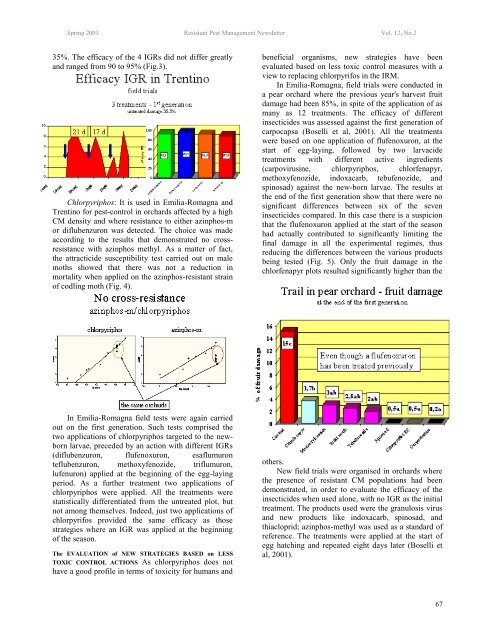Spring 2003 Resistant Pest Management Newsletter Vol. 12, <strong>No.2</strong>According to the results, codling moth resistancewas spread differently across the two regions:in Emilia-Romagna half of the samplescollected, when exposed to the resistancemonitoringtest for azinphos methyl anddiflubenzuron, showed a significant reduction inmortality in comparison to the susceptible strain;in Trentino the situation was less serious: thesamples analysed proved to be less susceptiblethan the reference strain, although the differencewas not statistically significant. A significantdecrease in mortality was only detected in asmall area.Recently, the apple-dipping test has been used todetect resistance directly on the larvae collected fromthe infested fruits in Trentino and Emilia-Romagna.According to the dose-response line evaluated fordifferent insecticides by Charmillot (in press) on asusceptible laboratory strain, a discriminating dose waschosen for diflubenzuron, flufenoxuron, indoxacarb,and spinosad. The collected larvae were divided intofour classes according to weight. The results obtainedhave shown that the mortality caused by thediscriminating concentration was closely linked to theweight of the field-collected larvae, even in thesusceptible strain. Only the first class of larvae, lessthan 10 mg in weight, responded to the treatment, aswas expected from the previously used monitoringtests. The preliminary results confirmed that there wasa large difference in mortality between susceptible andresistant (i.e.Copparo) strains when treated withdiflubenzuron, while the tested codling moth strainsshowed only a slight reduction when treated with theother three insecticides (Fig.1).damage within acceptable limits, and on the other,defining new strategies based on less toxic controlmeasures.IGR: As a result of their environmentally friendlycharacteristics, insect growth regulators are still themost suitable insecticides for Integrated FruitProduction, and their use for the codling moth controlis preferable when they prove to be effective. The fieldefficacy of IGR insecticides has been evaluated inthese two fruit-growing regions. In Emilia-Romagnathe trials were performed in orchards that had over thepast few years recorded a rise in damage in spite of theincrease in the number of insecticide treatments. On theother hand, in Trentino, where the level of the CMpopulation is generally lower, the tests were carried outon fruit-farms where CM proved to be less susceptiblethan the reference strain, although the difference wasnot statistically significant.Emilia-Romagna: The efficacy of two IGRs hasbeen tested (Boselli et al, 2001) in a pear-growingfruit-farm with a population of resistant CM. Twotreatments of flufenoxuron were applied against thefirst generation of carpocapsa, in comparision with twodiflubenzuron treatments. The first treatment for eachof the products was applied at the beginning of egglaying.For both products the second application wasrepeated 15 days after the start of the treatment. Undera severe infestation (27% of the fruits attacked in theuntreated plots) diflubenzuron cannot ensure anadequate crop protection (48.1% efficacy), whileflufenoxuron achieved a good efficacy rate (94.4%efficacy) (Fig.2). These results confirm thatflufenoxuron loses its ovicidal effect when used againsta resistant population, while maintaining its efficacyupon the larvae (Sauphanor et al., 1998).EFFICACY of DIFFERENT INSECTICIDES upon SENSITIVE andRESISTANT POPULATIONS of CYDIA POMONELLA Duringthe monitoring on the territory of the resistant CMpopulations, a series of field tests have been planned inthe two regions with a view to assessing, on the onehand, which active substances were capable ofconstituting a valid alternative for the containment ofTrentino: Several IGRs (flufenoxuron,diflubenzuron, novaluron, lufenuron) were comparedon an apple orchard against the first generation of CM.The first generation lasts longer than in the southernregions and three insecticide applications were neededto cover the entire egg-laying period. At the end of thefirst generation fruit damage in the untreated plot was66
Spring 2003 Resistant Pest Management Newsletter Vol. 12, <strong>No.2</strong>35%. The efficacy of the 4 IGRs did not differ greatlyand ranged from 90 to 95% (Fig.3).Chlorpyriphos: It is used in Emilia-Romagna andTrentino for pest-control in orchards affected by a highCM density and where resistance to either azinphos-mor diflubenzuron was detected. The choice was madeaccording to the results that demonstrated no crossresistancewith azinphos methyl. As a matter of fact,the attracticide susceptibility test carried out on malemoths showed that there was not a reduction inmortality when applied on the azinphos-resistant strainof codling moth (Fig. 4).beneficial organisms, new strategies have beenevaluated based on less toxic control measures with aview to replacing chlorpyrifos in the IRM.In Emilia-Romagna, field trials were conducted ina pear orchard where the previous year's harvest fruitdamage had been 85%, in spite of the application of asmany as 12 treatments. The efficacy of differentinsecticides was assessed against the first generation ofcarpocapsa (Boselli et al, 2001). All the treatmentswere based on one application of flufenoxuron, at thestart of egg-laying, followed by two larvacidetreatments with different active ingredients(carpovirusine, chlorpyriphos, chlorfenapyr,methoxyfenozide, indoxacarb, tebufenozide, andspinosad) against the new-born larvae. The results atthe end of the first generation show that there were nosignificant differences between six of the seveninsecticides compared. In this case there is a suspicionthat the flufenoxuron applied at the start of the seasonhad actually contributed to significantly limiting thefinal damage in all the experimental regimes, thusreducing the differences between the various productsbeing tested (Fig. 5). Only the fruit damage in thechlorfenapyr plots resulted significantly higher than theIn Emilia-Romagna field tests were again carriedout on the first generation. Such tests comprised thetwo applications of chlorpyriphos targeted to the newbornlarvae, preceded by an action with different IGRs(diflubenzuron, flufenoxuron, esaflumuronteflubenzuron, methoxyfenozide, triflumuron,lufenuron) applied at the beginning of the egg-layingperiod. As a further treatment two applications ofchlorpyriphos were applied. All the treatments werestatistically differentiated from the untreated plot, butnot among themselves. Indeed, just two applications ofchlorpyrifos provided the same efficacy as thosestrategies where an IGR was applied at the beginningof the season.The EVALUATION of NEW STRATEGIES BASED on LESSTOXIC CONTROL ACTIONS As chlorpyriphos does nothave a good profile in terms of toxicity for humans andothers.New field trials were organised in orchards wherethe presence of resistant CM populations had beendemonstrated, in order to evaluate the efficacy of theinsecticides when used alone, with no IGR as the initialtreatment. The products used were the granulosis virusand new products like indoxacarb, spinosad, andthiacloprid; azinphos-methyl was used as a standard ofreference. The treatments were applied at the start ofegg hatching and repeated eight days later (Boselli etal, 2001).67








